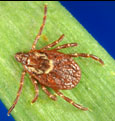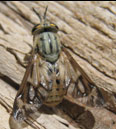



Overview
Tularemia is a disease of animals and humans caused by the bacterium Francisella tularensis. Rabbits, hares, and rodents are especially susceptible and often die in large numbers during outbreaks. Humans can become infected through several routes, including:
- Tick and deer fly bites
- Skin contact with infected animals
- Ingestion of contaminated water
- Laboratory exposure
- Inhalation of contaminated dusts or aerosols
In addition, humans could be exposed as a result of bioterrorism.
Symptoms vary depending upon the route of infection. Although tularemia can be life-threatening, most infections can be treated successfully with antibiotics.
Steps to prevent tularemia include:
- Use of insect repellent
- Wearing gloves when handling sick or dead animals
- Avoiding mowing over dead animals
In the United States, naturally occurring infections have been reported from all states except Hawaii.
Contact Us:
- Centers for Disease
Control and Prevention
Division of Vector-Borne Diseases (DVBD)
3150 Rampart Rd. Fort Collins, CO 80521
- 800-CDC-INFO
(800-232-4636)
TTY: (888) 232-6348 - New Hours of Operation
8am-8pm ET/Monday-Friday
Closed Holidays - cdcinfo@cdc.gov


